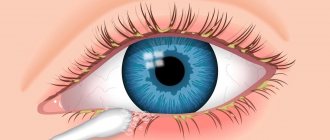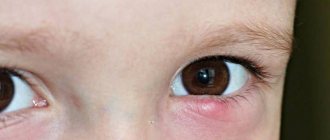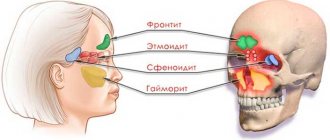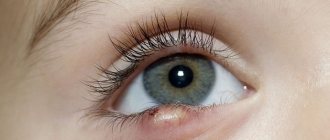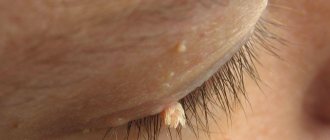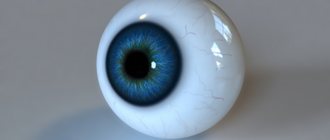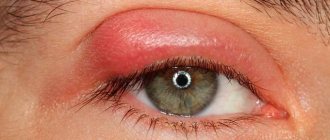Features of the development of the disease
A chalazion is a benign formation that forms on the edge of the eyelid as a result of blockage of the sebaceous gland, which produces a fatty secretion necessary for lubricating the eyelids and cornea. The following factors can lead to blockage of the meimobian gland:
- inflammatory process;
- eye injury;
- entry of a foreign body;
- increased oiliness of the skin;
- diabetes;
- hormonal imbalance;
- gastrointestinal pathologies;
- genetic predisposition.
Chalazion can occur at any age, but most often the pathology is diagnosed in people over 30 years of age. The likelihood of developing a chronic inflammatory process increases with frequent stress, hypothermia, viral diseases and lack of personal eye hygiene. At the initial stage of development of the pathological process, a small rounded compaction, similar to a grain, forms under the skin of the eyelid. At first, the hailstone is small and almost invisible, but as the inflammation progresses, it becomes larger, reaching a diameter of 0.5 cm.
In addition to a pronounced cosmetic defect, such a neoplasm causes severe discomfort and is accompanied by a number of unpleasant symptoms:
- swelling;
- hyperemia;
- itching;
- lacrimation;
- soreness;
- increased sensitivity.
If the chalazion continues to grow, then strong pressure is exerted on the eyeball, causing a decrease in the quality of vision and the development of various complications. Sometimes the nodule becomes infected, leading to its suppuration and further opening.
Why does a chalazion break out?
Such a lump on the organs of vision is formed mainly on the edge of the eyelid due to blockage of the sebaceous gland and the accumulation of secretory fluid in it.
A chalazion can burst on its own in the following pathological conditions:
- long-term inflammatory and purulent process;
- complete blocking of the sebaceous gland on the eyelids;
- demodectic blepharitis;
- relapse of the disease in a more severe form.
Main symptoms
Sometimes the temperature may rise.
The capsule with purulent contents mostly breaks out. In this condition, the sore eyelid becomes very inflamed and may become very red. Swelling affects the entire affected eye. If the chalazion opens and bursts, then you can see pus and blood starting to flow out of the pathological formation. The patient experiences pain, the tissue in the area of the damaged organ swells greatly, and the body temperature often rises. When the cause of the formation is demodectic blepharitis, the disease is accompanied by burning and itching.
Chalazion ruptured: dangerous consequences
If the pathological formation ruptures naturally, complications may arise. When the chalazion is opened in this way, the pus often does not come out completely, which becomes the root cause of repeated damage and aggravation or complication of the disease. The inflammatory-purulent process often spreads to the cornea, causes an acute form of inflammation of the eyelids, and disrupts visual function. Against the background of weakened immunity, suppuration of the chalazion occurs, provoking the development of phlegmon or abscess of the lower or upper eyelids. If the inflammatory sac is partially cleared of pus when the formation is opened, then a relapse of the disease in a more severe form is possible with the formation of a fistula tract.
What to do if the chalazion bursts?
In many cases, chalazion does not cause significant discomfort and resolves on its own within a few weeks. Can a chalazion rupture on its own? In case of infection, the suppurating neoplasm chalazion can burst, causing the release of purulent contents onto the surface of the conjunctiva. An opened chalazion is accompanied by the following symptoms:
- pain;
- hyperemia;
- itching;
- hyperthermia;
- swelling;
- discharge of pus and blood.
If the chalazion bursts, there is a high probability of secondary infection and the development of severe complications. A burst hailstone is a dangerous condition, but there is no need to panic when such a situation occurs. What to do in such a situation? In case of such a phenomenon, first aid should be provided immediately:
- Rinse the wound thoroughly with a solution of Chlorhexidine or Miramistin.
- If possible, use antibacterial eye drops Albucid or Tsipromed.
- If the chalazion breaks out in the evening, apply a compress with Levomekol ointment to the affected eye overnight, which helps disinfect and draw out the purulent contents.
- To relieve inflammation and unpleasant symptomatic manifestations, it is recommended to apply the pulp of an aloe leaf to the wound.
After providing first aid, it is necessary to contact an ophthalmologist as soon as possible to select complex therapy.
Do you really have a chalazion?
Firstly, in order to talk about how terrible this complication is, you need to make sure that you are suffering from chalazion. This disease is often confused with barley and for correct diagnosis it is necessary to consult a doctor. Also, to better understand how chalazion differs from barley, read the article on this topic directly on our website.
Some experts argue that a breakthrough of such a formation is a terrible complication, while others say that this is an expected outcome of treatment.
In any case, if the tubercle breaks through, you must contact a specialist as soon as possible, who will conduct an examination and prescribe treatment.
Treatment
Treatment of an opened chalazion depends on many factors and is selected on an individual basis. If, after the hailstone bursts, purulent contents remain inside the capsule, then the first thing the doctor prescribes is its surgical removal. If this is not done, then there is a high risk of complicated relapse. After surgical removal of the chalazion, conservative therapy is selected aimed at preventing the development of complications. The most commonly recommended medications are:
- glucocorticosteroid Kenalog (suspension administered intramuscularly);
- anti-inflammatory drops Diclofenac;
- decongestant drops Dexamethasone;
- boric acid solution 2%;
- antibacterial ointment Floxal.
Read in a separate article: Chalazion of the lower eyelid: causes, treatment and removal surgery
In addition to drug therapy, physiotherapeutic treatment is prescribed, aimed at reducing the inflammatory process, improving blood circulation in the affected tissues, removing swelling and speeding up wound healing. Physiotherapy accelerates the healing process and quickly eliminates unpleasant symptomatic manifestations, reducing the risk of complications. After opening the chalazion, the following physiotherapeutic procedures are recommended:
- medicinal electrophoresis;
- UHF therapy;
- magnetic therapy;
- phonophoresis;
- laser therapy.
To achieve the best effect, it is additionally recommended to use traditional medicine (aloe juice, marshmallow root infusion, cabbage juice).
If the chalazion has ruptured, self-medication is strictly not recommended, as this can lead to serious complications.
Stages of chalazion development
The formation of a chalazion occurs in several stages. Each of them has its own characteristic features. During the development of chalazion, the following clinical pictures are observed:
- Stage of cyst formation. It goes unnoticed. A tiny lump may be discovered completely by accident.
- Stage of cyst growth. The compaction becomes noticeable in many cases almost a month after the start of its formation. Its dimensions are quite small. On palpation, the mobility of the neoplasm is noted.
- Chalazion inflammation stage. Occurs in those patients who started treatment late. The seal greatly increases in size, beginning to put pressure on the apple of the eye. A common cause of the inflammatory process is the penetration of infection into the cyst or the breakthrough of a purulent seal, in which its contents enter the blood.
- Chalazion resorption stage. The lump resolves on its own if treatment is started on time. Otherwise, you have to remove the cyst surgically.
Depending on the physiological characteristics of the body, each person tolerates chalazion differently. Some people have too low immunity and cannot survive without the spread of the inflammatory process, while in others the chalazion goes away without complications and quite quickly.
Prevention
If the chalazion has opened, there is a risk of recurrence of the disease. You can avoid relapse if you follow the following preventive measures:
- eat properly, balanced;
- to live an active lifestyle;
- strengthen immunity;
- avoid stressful situations;
- promptly treat infectious diseases;
- prevent hypothermia of the body;
- maintain eye hygiene;
- adhere to the rules of wearing contact lenses.
If frequent relapses of chalazion are observed, you should undergo a medical examination, as this may be a manifestation of diabetes mellitus.
Author of the article: Kvasha Anastasia Pavlovna, specialist for the website glazalik.ru Share your experience and opinion in the comments.
Causes of chalazion
The disease can cause various problems. Chalazion is often caused by blockage of blood vessels or obstruction of the ducts of the sebaceous glands. Since the meibomian glands are designed to produce fluid that comes out of the lacrimal glands along with tears, when a small round hole is blocked, a lot of fluid accumulates in it, which eventually becomes a narrow passage. This will cause a lump to form and an inflammation called hailstone. Sometimes it appears due to a recent stye that has not been fully cured. In some situations, hailstones were observed in people who had recently suffered from conjunctivitis or blepharitis. This was due to the fact that during these diseases, swelling appeared, which prevented the release of fluid from the sebaceous glands.
It can develop in people with oily skin, diabetes, rosacea, seborrhea and gastrointestinal diseases. Also, factors for the occurrence of this disease include stress, hypothermia, hypovitaminosis, colds and infection that got into the eye due to non-compliance with personal hygiene rules or improper use of contact lenses.
The chalazion consists of granulation tissue and many epithelial and giant cells.
The photo shows the eye of a person with a chalazion.
How to diagnose chalazion inflammation
A chalazion visually resembles a small hailstone-shaped compaction. The tumor has clear boundaries, is easily palpable, and most often painless.
How does “hailstone” differ from “barley”:
- no discomfort at the initial stage;
- the swelling does not disappear after a few days;
- the neoplasm increases in size over time;
- Unlike “barley,” “hailstone” is clearly distinguishable from both the outer and inner sides of the eyelid.
When a chalazion develops, the tumor increases in size over time.
Blockage of the meibomian gland ducts can occur in the following cases:
- entry of microscopic foreign bodies into the duct, for example, lumps of mascara, dust;
- inflammatory process due to an infectious disease;
- weakened immunity, for example, due to vitamin deficiency;
- irregular hygiene procedures.
A chalazion is also called a meibomian cyst. The tumor may open as a result of conservative treatment. But if the chalazion does not go away, it can cause ophthalmic diseases. The inflamed “pouch” increases in size and puts pressure on the cornea of the eye. As a result, clouding of the cornea or the development of astigmatism is possible. Therefore, under no circumstances should you let the disease take its course!
Surgical removal of a chalazion
It also happens that treatment of a chalazion begins at an advanced stage, and traditional medicine is no longer able to help, then ophthalmologists prescribe surgical removal of the chalazion. This procedure is done using a laser or scalpel. Chalazion removal using laser is a very effective treatment because this method occurs without any incisions and it does not leave behind any scars. Therefore, to cure chalazion, most doctors recommend laser removal. This is a low-traumatic operation that does not require bandages afterward. After surgery, you should not get your eyes wet, and you should not remove any crusts that have formed. This operation in some clinics is prescribed from the age of 14.
